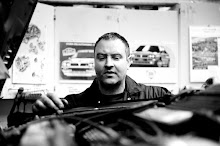Abbreviations:
IC = Intercooler
Ambient = The temp of the air outside the car
Charge air = the air coming from the turbo to the engine
Tubes = These are the passageways that the charge air goes through within the intercooler.
AKA = As commonly known as...
CFM = Cubic feet per Minute (A measure of airflow)
I don't like imperial measurements, we (in the UK) have been Metric since 1971. BUT for the sake of simplicity here I am going to write in inches (") because it makes the numbers easier to digest for you.
Ok, let's start with the basics, the turbo on an engine compresses the air so more of it can be forced into the engine: More air (and petrol to match) = more power.
The main trade off is that compressing air also makes it hot, this is where the intercooler comes in - to cool the charge air. Cool air = more power AND reliability - hot air causes uncontrolled detonation within the combustion chamber which in turn leads to major engine damage and failure. Colder air is more dense (It contains more oxygen) so it gives more power.
The intercooler must meet two criteria, the first we just covered, the second is where a lot of people mess up: *It must be able to flow enough air for the engine to breathe properly*, get it too small and you will strangle the engine and throw away potential power.
Here is how you label the dimensions of an intercooler:
Let's look at a 'cooler in detail, there are two types of core: Bar & plate and tube & fin, it refers to the way they are manufactured and the shape of the tubes, B&P is more desireable as it flows better.
Bar and plate detail:
Tube and fin detail (an integrale IC):
Take a look at the zig-zag fins, these are known as 'Turbulators' or just fins, this is because they cause turbulance in the air. Basically the hot air hits and bounces over the turbulators as it goes through the tubes, when it does this it loses its heat to them, the fins then pass this heat (by convection) to the outside of the cooler, a similar process then happens - cooler ambient air passes through the external fins and cools them.
It is all down to heat transfer, basically an intercooler is a large heat sink, it takes the heat from the air within it then holds it until it is cooled by the air outside. The next facts are very important:
Turbulators slow the air to take the heat from them, the longer the tubes, the more you slow down the air, (velocity) do we want the air to slow right down? Of course not!! Slow lazy air = bad throttle response, AKA: Turbolag. Loss of power, response, economy etc.
FACT:
In a good efficient core the majority of air cooling is done in the first few inches of tube.
The rest is mainly waste, yes it drops the temp a little bit more, but nothing worth shouting about and is more than offset by the fact that that the air has practically gone to sleep....
What is a good figure here? About 7 to 8 inches, 12 - 16 as a max.
7 - 8"? Really?
Yep.
So why do aftermarket manufacturers make 'double pass' intercoolers which make the air go through 48" of tube and a U bend?
To make money out of people who don't know anything about ICs. Take a look here:
Will there be any flow figures (CFM)? Pressure drop? MPG? Power? Nope.
If you see a double pass intercooler for sale then just leave it on the shelf please, hopefully someone will melt it down and make something useful from it.
Please go to Part 2.
.



